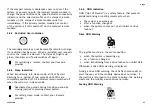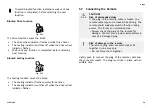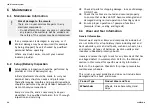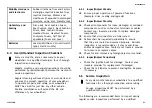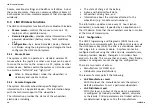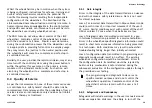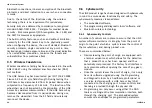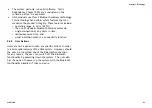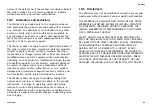
Whilst the wheelchair may be in motion when the system
is being configured, instructions for safe use, training and
built-in safety mechanisms minimize the potential for
non-life threatening injuries resulting from inappropriate
configuration of the wheelchair. The likelihood of the
aforementioned hazardous situation occurring is remote. A
human intermediary, knowledgeable in the control system
and specific user needs, can intervene to prevent harm to
the wheelchair user during wheelchair set-up.
The P&D tools do not allow direct control of the LiNX
wheelchair. Complete control of the wheelchair remains
with the end-user at all times. Should a user determine
during the customization process that the wheelchair set-up
is inappropriate in providing full control in everyday usage,
they may return the joystick to the neutral position and
the wheelchair will come to a complete and safe stop in
a controlled manner.
Similarly, the user, provider, therapist or clinician, may at any
time turn-off the control system using the power button/s
within the system (for example, on the primary remote
module or the attendant control unit). Such action will
also bring the wheelchair to a complete and safe stop in
a controlled manner.
9.4 Quality of Service
As per the risk assessment, none of these items can cause
or contribute to a safety hazard should the data link be
compromised. Data latency and/or the probability of loss of
service creates an inconvenience only and does not inhibit
the user’s therapy or treatment.
9.4.1 Data Integrity
Errors in the integrity of the data transmitted are a nuisance
and will not cause a safety related issue. Data is not used
for clinical purposes.
Loss of, or incorrect data transmitted in Mouse Mover mode
could result in loss of, or incorrect movement of the user’s
PC cursor. Similar conditions exist with normal off-the-shelf
USB or wireless PC mice when their batteries are low.
Loss of diagnostic data transmitted could result in a gap
in historical information presented to a service technician.
Errors in the wheelchair-specific diagnostic information could
result in short term erroneous information being presented
to a technician. Both conditions may result in wheelchair
troubleshooting taking longer than initially estimated.
Loss of configuration data transmitted in programming and
diagnostic mode would result in no effect. The existing
wheelchair configuration would be maintained. Errors in
the configuration data transmitted would be rejected by
built-in safety mechanisms and/or detected during the
subsequent evaluation of the configuration updates through
the prescribed user testing.
The programming and diagnostic tools serve no
specific medical purpose and do not control the
wheelchair's operation. Complete control of the
wheelchair's actions remain with the user at all
times.
9.4.2 Safeguards and Redundancy
Safeguards will include warnings in the user manuals around
minimum separation distances, the ability to turn off the
1195718-A
39
Содержание LINX ACU
Страница 1: ......



